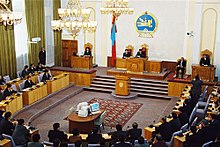Political system in Mongolia
The political system in Mongolia has developed from a one-party system since 1990 and is considered a parliamentary democracy. In 1989, as in other socialist countries, the Unity Party was overthrown in Mongolia . A multi-party system then emerged. In 1990 the first elections took place under the new conditions.
The constitution, which came into force in 1992, took the Basic Law of the Federal Republic of Germany and especially the French constitution as models. In 2001 there was a constitutional revision. B. the influence of the president was again somewhat reduced.
The separation of powers between the legislature, executive and judiciary does not quite correspond to Western European ideas: the legislature is made up of the President and Parliament. The parliament consists of only one chamber. The president is directly elected for a four-year term, with a limit of two terms. He is simultaneously head of state, commander in chief of the armed forces and chairman of the national security council. As in France, the President can veto bills that can only be overruled with a two-thirds majority in parliament. The chairman of parliament is also the deputy president of the state and a member of the national security council.
The unicameral parliament is called the Great State Chural , has 76 members and is elected every four years. Up to the parliamentary elections in Mongolia in 2012 , 48 MPs were directly elected in as many constituencies according to the majority principle, the remaining 28 seats were divided according to proportional representation among all parties that received at least five percent of the vote. Shortly before the 2016 election, the electoral system was converted to a pure majority system, so that now all 76 members are elected according to the majority principle. With 28 constituencies in the capital Ulaanbaatar and 48 constituencies in the rest of the country.
The executive branch consists of the President and the rest of the government. The President proposes the Prime Minister to Parliament . This and the other members of the government must be confirmed by parliament and also serve for four years.
Political history

After the country gained independence from China in 1921, the Mongolian People's Revolutionary Party was founded. The communist revolution took place with significant support from the Soviet Union , although the monarchy was temporarily still formally tolerated with the Bogd Khan as emperor, who also saw himself as a political leader and had planned the establishment of an independent theocratic Mongolian empire. Mongolia only got its own constitution in 1924 after the death of the emperor. In principle, all citizens aged 18 and over were given the right to vote, but traders, moneylenders, former nobles and monks were excluded. A council system was created based on the Soviet model: the Great State Chural elected the Small State Chural, which initially only had five members. The Little Chural, in turn, elected a praesidium and a council of ministers with twelve members. In 1951 the Little Chural was abolished.
Stalin's henchmen acted against Mongolian culture and religion with extreme brutality. The Mongolian People's Revolutionary Party (MRVP) ruled as a unified party until 1990 . After the democratization of the country, Buddhism was able to develop again in Mongolia and the successor of Bogd Khan also appeared in public as the 9th Bogd Gegen.
In addition to the Great State Chural with around 430 members, the second chamber, the Small Chural with 50 seats, was set up again. The 1992 constitution abolished the second chamber and reduced the number of members of parliament.
Individual evidence
- ↑ Konrad Adenauer Foundation: landslide victory of the Mongolian People's Party , July 1, 2016
- ^ Marion Wisotzki, Ernst von Waldenfels, Erna Käppeli: Mongolei. History. Trescher Verlag, 2014
